Friedrich-Wilhelm-Preise 2024

Professor Ulrich Rüdiger, Rektor der RWTH Aachen University, zeichnete 22 herausragende Absolventinnen und Absolventen mit dem Friedrich-Wilhelm-Preis 2024 aus. ©Andreas Schmitter
Unter dem Dach der Fakultät für Elektrotechnik und Informationstechnik entwickelten sich drei herausragende Persönlichkeiten, die sich aufgrund ihrer exzellenten Abschlussarbeiten unter den diesjährigen Preisträgern der Friedrich-Wilhelm-Preise wiederfanden.
Christian Fester, wissenschaftlicher Mitarbeiter am Lehrstuhl für Übertragungsnetze und Energiewirtschaft der RWTH Aachen University, wurde für seine Masterarbeit mit dem Titel „Validierung und Weiterentwicklung eines Verfahrens zur Topologie-Optimierung des deutschen Übertragungsnetzes anhand realer Betriebsplanungsdaten“ ausgezeichnet. Die Arbeit liefert innovative Impulse für die Integration der Optimierung von Schalthandlungen in die Vorschauprozesse im deutschen Übertragungsnetz.
Nach Abschluss seines Bachelorstudiums an der RWTH Aachen University absolvierte Maximilian Henri Vincent Tillmann das T.I.M.E.-Double-Degree-Programm, welches den Erwerb eines Master of Science in Elektrotechnik, Informationstechnik und Technischer Informatik an der RWTH Aachen University sowie der Keio University ermöglicht. Seine mit dem Friedrich-Wilhelm-Preis ausgezeichnete Abschlussarbeit trägt den Titel „Investigation on Autoencoder Models for Online System Identification“.
Im Rahmen dieser akademischen Auszeichnung wurde zudem Dr. Eduard Heidebrecht für seine Dissertation mit dem Titel „Alternative Concepts for Wideband Doherty Power Amplifiers“ geehrt. Er forscht am Lehrstuhl für Hochfrequenzelektronik der RWTH Aachen University mit dem Schwerpunkt auf nichtlinearem, effizientem PA-Design und ist spezialisiert auf den Entwurf von breitbandigen Doherty-Leistungsverstärkern (DPA) in CMOS-, MMIC- und Hybridsystemen von unter 6 GHz bis zu mmWave-Frequenzen.
Die Friedrich-Wilhelm-Preise werden alljährlich seitens der namensgebenden Stiftung in Gestalt eines Preisgeldes an Studierende sowie Forschende der RWTH Aachen vergeben, die auf Basis ihrer herausragenden Leistungen im Kontext ihrer Abschlussarbeiten für diese Auszeichnung ausgewählt wurden.
Die Förderung von Forschung und Lehre stellt ein zentrales Anliegen der Stiftung dar. Der Name der Stiftung geht auf den preußischen Kronprinzen und späteren Kaiser Friedrich Wilhelm III. zurück, der im Jahre 1858 unter Verwendung einer Geldspende der Aachener und Münchener Feuerversicherungsgesellschaft ein Polytechnisches Institut in der Rheinprovinz gründete. Damit legte er den Grundstein für die Rheinisch-Westfälische Technische Hochschule sowie für die 1865 von der Rechtsvorgängerin der heutigen Aachener und Münchener Beteiligungsgesellschaft gegründete Friedrich-Wilhelm-Stiftung. Seither stellt die Förderung von Forschung und Lehre, die Unterstützung von Studierenden und Forschenden der RWTH, ihr zentrales Anliegen dar.
Otto-Junker-Preise 2024
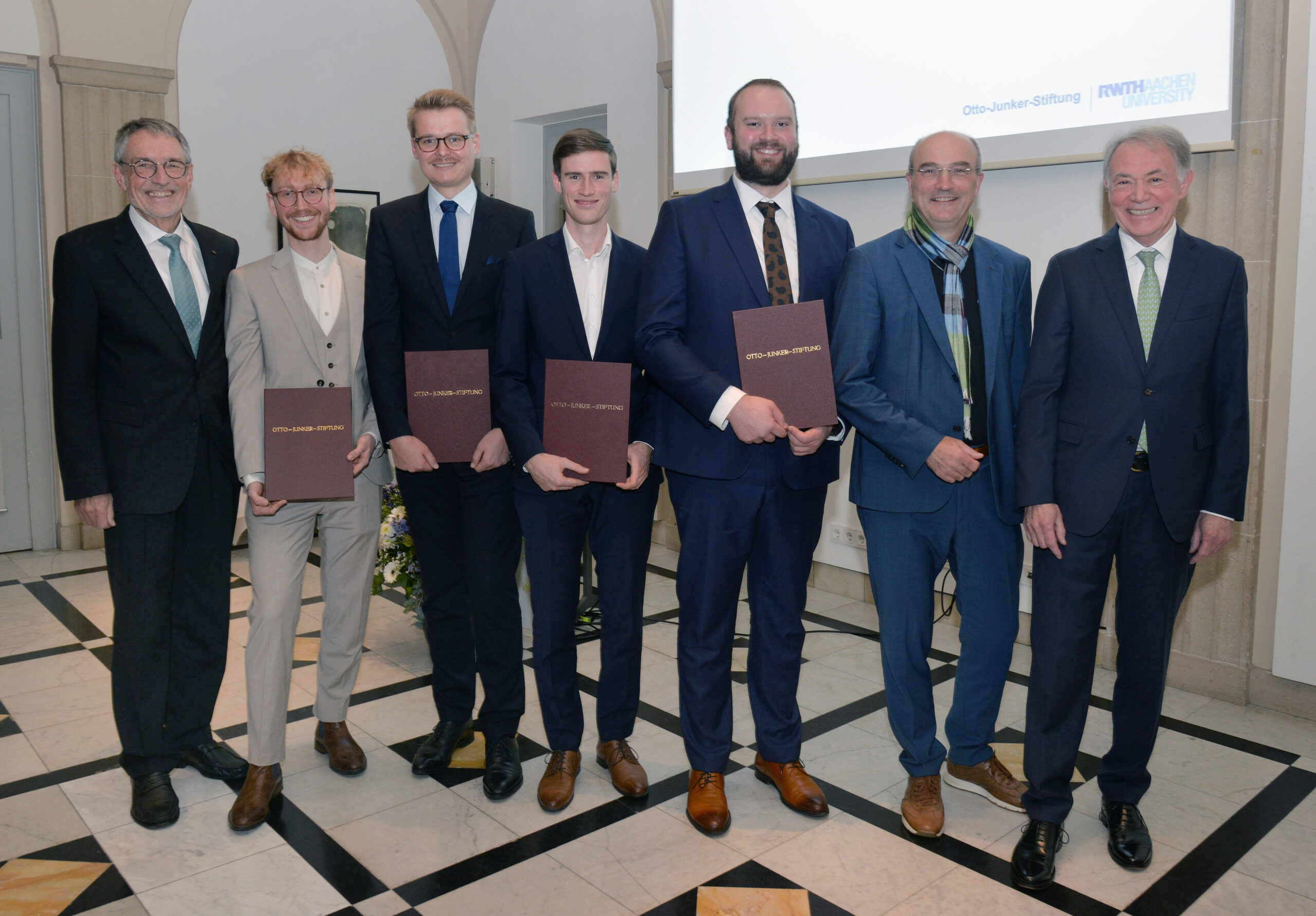
Wolfgang Bleck (links), Udo von Berg (rechts) und Ulrich Rüdiger (zweiter von rechts) gratulierten den Preisträgern Jan Krusenbaum (zweiter von links), Gerrit Ipers (dritter von links), Daniel Baggen (vierter von links) und Moritz Diewald (dritter von rechts). ©Andreas Schmitter
Im Rahmen der diesjährigen Preisverleihung des Otto-Junker-Preises wurden mit Daniel Baggen und Gerrit Ipers gleich zwei herausragende Nachwuchstalente für ihre exzellenten Studienleistungen gewürdigt, die aus dem Fachbereich der Elektrotechnik und Informationstechnik stammen.
Daniel Baggen, geboren 2000 in Aachen, immatrikulierte sich nach dem Abitur am Städtischen Gymnasium Herzogenrath für den Bachelorstudiengang Elektrotechnik, Informationstechnik und Technische Informatik an der RWTH Aachen University. Sein Masterstudium schloss er mit einer Arbeit über „Design und Inbetriebnahme eines hochintegrierten DC-DC-Wandlers für die Erzeugung von grünem Wasserstoff“ am Institut für Stromrichtertechnik und Elektrische Antriebe ab. Professor Rik W. De Doncker betreute die Masterarbeit. Seit November 2023 ist Daniel Baggen als Promotionsstudent im Bereich Leistungselektronik tätig.
Gerrit Ipers, 27 Jahre alt, stammt gebürtig aus Viersen. Nach dem Erwerb der Allgemeinen Hochschulreife an der Liebfrauenschule Mülhausen in Grefrath absolvierte er zunächst ein Bachelor- und später ein Masterstudium der Fachrichtung Wirtschaftsingenieurwesen mit Schwerpunkt Elektrische Energietechnik an der RWTH Aachen University. Die Erstellung seiner Masterarbeit mit dem Titel „Rapid Prediction of Electro-Chemo-Mechanical Degradation of Li-Ion Batteries for End-of-Life Options“ erfolgte am Massachusetts Institute of Technology in den USA. Zuvor absolvierte er das T.I.M.E.-Doppel-Master-Programm am KTH Royal Institute of Technology in Stockholm. Die Betreuung seitens der RWTH erfolgte durch Professor Dirk Uwe Sauer, ebenfalls vom Institut für Stromrichtertechnik und Elektrische Antriebe. Seit Mai 2023 ist Gerrit Ipers als Technischer Projektleiter bei einem schwedischen Automobilzulieferer tätig.
Moritz Diewald aus der Fachgruppe Materialwissenschaft und Werkstofftechnik der Fakultät für Georessourcen und Materialtechnik überzeugte mit seiner Masterarbeit, in der er die unterstöchiometrische Verbrennung als Teil der mehrstufigen flammlosen Oxidation numerisch und experimentell untersuchte. In der gleichen Fachgruppe wurde Jan Krusenbaum für seine Masterarbeit mit dem Titel „Thermische Konditionierung von Li-Ionen-Batterieschreddern im Rahmen eines neuartigen Recyclingverfahrens: Auswirkungen der Prozessgasatmosphäre sowie weiterer Determinanten auf die Rückgewinnung des kritischen Elements Lithium“ wurde Jan Krusenbaum ausgezeichnet.
Die Verleihung der Auszeichnungen erfolgte im Rahmen einer festlichen Veranstaltung. Die Übergabe wurde durch Udo von Berg, Vorstand der Otto-Junker-Stiftung, und durch Ulrich Rüdiger, Rektor der RWTH Aachen University, vorgenommen. Wolfgang Bleck, emeritierter Professor und Vorsitzender des Wissenschaftlichen Beirats der Stiftung, bekundete seine Glückwünsche.
Die Auszeichnungen, die den Namen des Stiftungsgründers Dr. Otto Junker tragen, werden jährlich an herausragende Absolventinnen und Absolventen der Fakultät für Elektrotechnik und Informationstechnik sowie der Fachgruppe Materialwissenschaft und Werkstofftechnik in der Fakultät für Georessourcen und Materialtechnik vergeben. Die 1970 ins Leben gerufene Stiftung hat sich der Förderung des wissenschaftlichen Nachwuchses verschrieben und unterstützt eine Vielzahl von Einzelprojekten.
Die herausragenden Leistungen dieser vier Absolventen verdeutlichen nicht nur ihre individuelle Exzellenz, sondern ehren zugleich die RWTH Aachen University als Ausbildungsstätte für brillante Persönlichkeiten. Wir möchten Daniel Baggen, Gerrit Ipers, Moritz Diewald und Jan Krusenbaum zu dieser wohlverdienten Anerkennung gratulieren und ihnen für ihre vielversprechenden Karrierewege weiterhin viel Erfolg wünschen.
Tag der Elektrotechnik und der Informationstechnik 2024
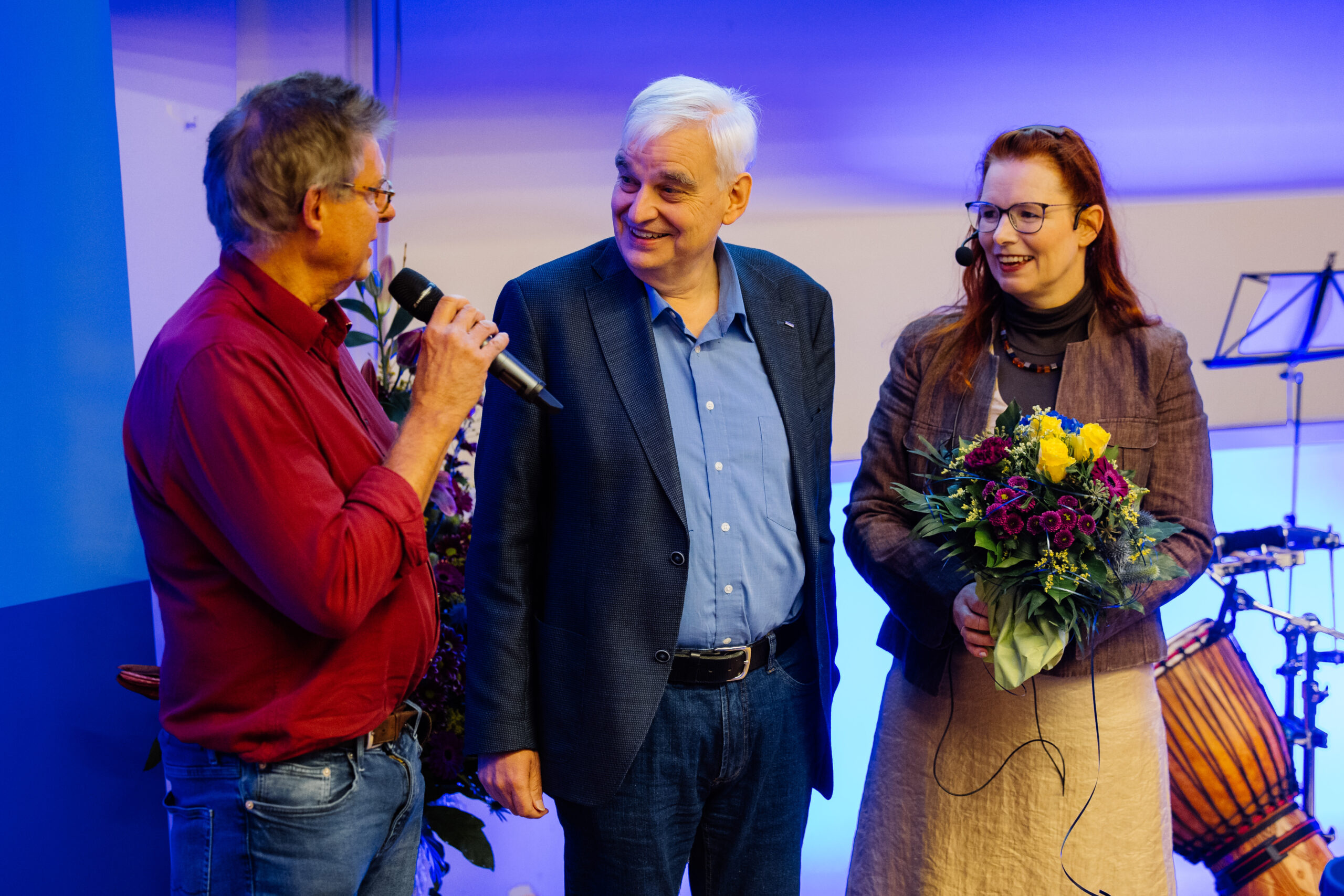
Nach einer fünfeinhalbjährigen Amtszeit als Dekan der Fakultät für Elektrotechnik und Informationstechnik wurde Professor Jens-Rainer Ohm (links) feierlich verabschiedet. Die Verabschiedung erfolgte durch Geschäftsführerin Martina Dahm (rechts im Bild) und den neuen Dekan der Fakultät, Professor Albert Moser (in der Mitte). © Martin Braun
Am 25. Tag der Elektrotechnik und Informationstechnik (TDEI), der am 22.11.2024 stattfand, präsentierten wir unseren diesjährigen Erfolg und brachten wieder Unternehmen, Studierende, Fakultätsangehörige und Absolvent*innen zusammen.
Die Fakultät für Elektrotechnik und Informationstechnik der RWTH Aachen genießt seit über fünf Jahrzehnten einen exzellenten Ruf als Ausbildungsstätte für hochqualifizierte und verantwortungsbewusste Ingenieurinnen und Ingenieure. Dies wird regelmäßig in nationalen und internationalen Rankings belegt, in denen die Fakultät stets vordere Plätze erreicht. Der Dekan der Fakultät, Professor Albert Moser, eröffnete den Tag der Elektrotechnik und Informationstechnik mit einem Jahresrückblick sowie der Begrüßung neuer Lehrstuhlinhaber im Team der Fakultät.
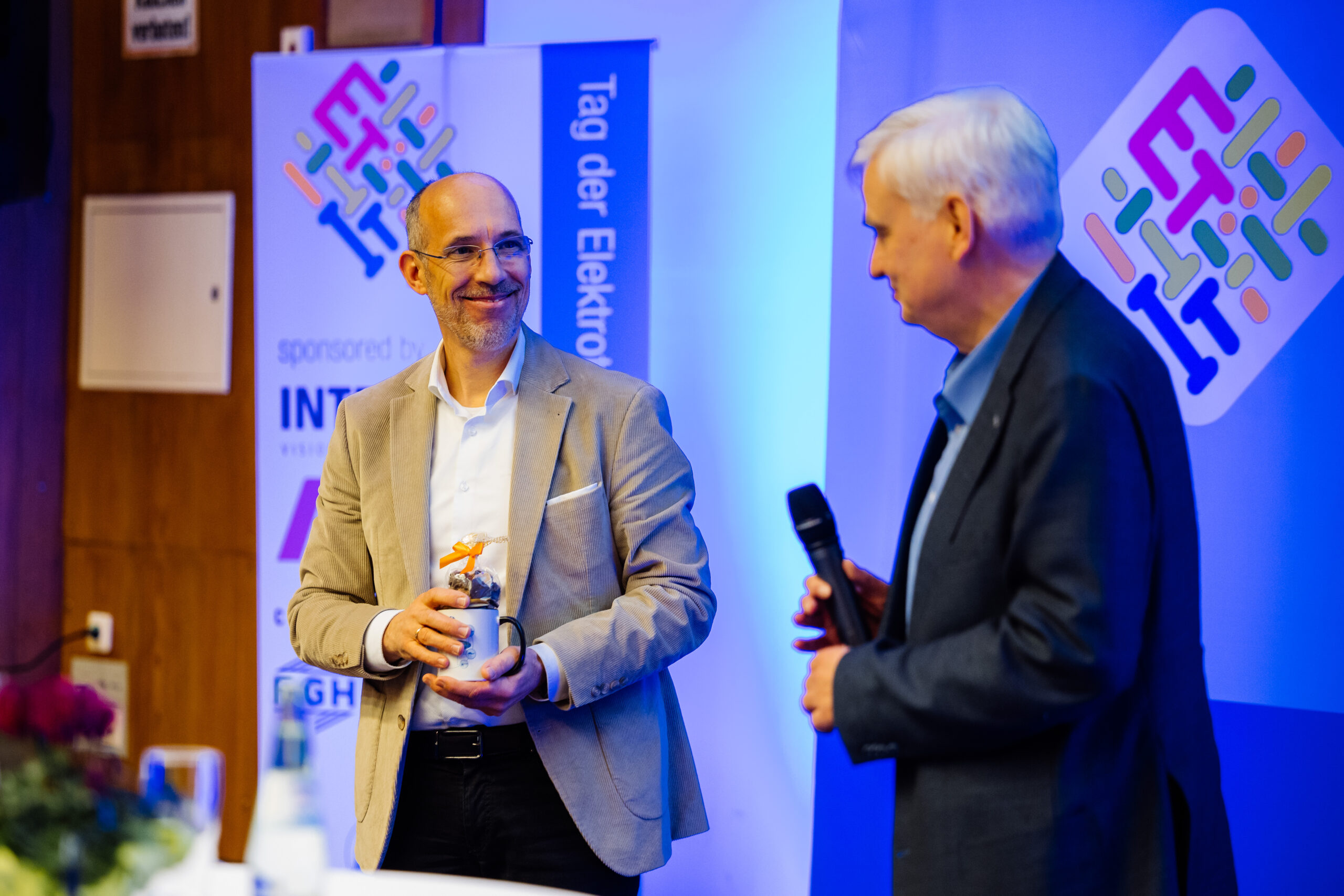
Von rechts: Professor Alber Moser mit Professor Volkmar Schulz © Martin Braun
Das Kompetenzfeld Medizintechnik wird durch Professor Volkmar Schulz mit seiner Expertise auf dem Gebiet der Bildverarbeitung bereichert. Nach langjähriger Leitung der Gruppe „Physics of Molecular Imaging“ beim Institut für Experimentelle Molekulare Bildgebung hat er im September 2024 den Lehrstuhl für Bildverarbeitung an der Fakultät für Elektrotechnik und Informationstechnik übernommen.
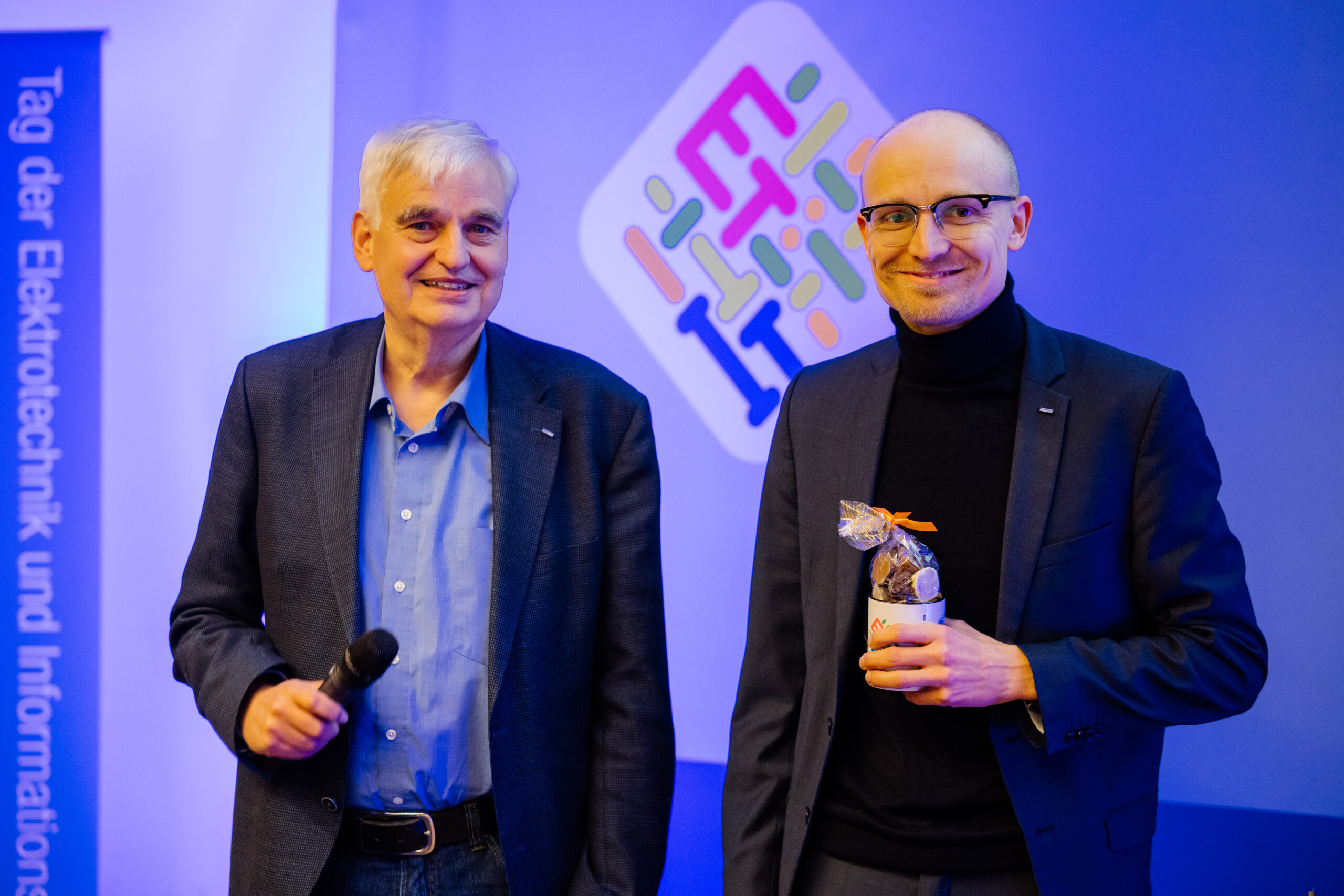
Von rechts: Professor Simon Steentjes und Professor Albert Moser © Martin Braun
Professor Simon Steentjes hatte vor der Veranstaltung bereits zu erkennen gegeben, dass er seit geraumer Zeit und im Zuge seiner persönlichen Agenda darauf hingearbeitet habe, an die RWTH Aachen zurückzukehren.
„Die Arbeit mit jungen Menschen bringt stets neue Ideen und hilft mir, am Puls der Zeit zu bleiben. Es ist schön, nun wieder in der Lehre aktiv zu sein“, erklärt Professor Steentjes, der im Oktober den Lehrstuhl für Elektrische Maschinen und Anlagen übernommen hat.
Zuvor in führenden Positionen bei der Audi AG sowie der Hilti Group tätig, verfügt Professor Steentjes über langjährige Erfahrung in der Industrie.

Professor Peter Jax © Martin Braun
Ein weiterer Programmpunkt war der Bericht des Studiendekans, Professor Peter Jax, Leiter des Instituts für Kommunikationssysteme. Basierend auf quantitativen Erhebungen analysierte er die akademische Lehre in den angebotenen Studiengängen der Fakultät und zeigte das Potential für weitere Entwicklungen auf.
Anschließend überreichte Professor Jax den Team Award, welcher in diesem Jahr an Cinar Algül, Maxim Klosa und Wenjie Zeng verliehen wurde. Die drei Studierenden hatten sich durch Ihre Arbeit im Projekt der Elektrotechnik und Informationstechnik – MATLAB meets Lego Mindstorms – in besonderem Maße hervorgetan.

Best Bachelor Award Gewinner Fritz Stracke © Martin Braun
Ein wesentlicher Faktor für den Erfolg ist die konstruktive Zusammenarbeit mit anderen Unternehmen, welche den Studierenden die Möglichkeit bietet, sich mit anspruchsvollen Projekt- und Abschlussarbeiten zu befassen und daran mitzuwirken. Im Rahmen der Veranstaltung TDEI präsentierte sich der Goldsponsor Intravis in einem Interview. Des Weiteren wurde der diesjährige Rohde & Schwarz Best Bachelor Award an Fritz Stracke verliehen. Der Studierende, der sich ebenfalls durch sein Engagement in der Fachschaft für Elektrotechnik und Informationstechnik auszeichnet, wurde für seine Bachelorarbeit mit dem Titel „Untersuchung des Bare-Metal Supports von Rst Unikernels in heterogenen Rechensystemen“ gewürdigt.
Ein weiterer Höhepunkt der Veranstaltung war der Festvortrag von Professor Andreas Hierlemann von der ETH Zürich mit dem Titel „Interfacing with brain cells at subcellular resolution“. Für spannende Einblicke sorgte auch das Interview mit Professor Sven Ingebrandt, Leiter des Instituts für Werkstoffe der Elektrotechnik 1 an der RWTH Aachen University, sowie die Vorstellung des Keyvisuals und der Institutsprojekte.
Die feierliche Verabschiedung der Absolventinnen und Absolventen bildete den traditionellen Abschluss der Veranstaltung. Nach der namentlichen Vorstellung auf der Bühne überbrachte der Dekan jedem Einzelnen seine Gratulation zum Studienerfolg.
Professor Antonello Monti verabschiedete die Studierenden auf seine eigene Art und Weise. Einst hatte er beim TDEI 2019 mit einem Überraschungsauftritt für große Begeisterung gesorgt. In diesem Jahr kehrte er mit der ERC Band auf die Bühne zurück. Im Rahmen der Darbietung wurden die musikalischen Kompositionen „Knockin on E.ON´s Door“ sowie „AC to Hell“ präsentiert.
Für die tatkräftige Unterstützung bei der Organisation und Durchführung des Tages der Elektrotechnik und Informationstechnik möchten wir uns bei allen Fakultätsmitgliedern und Helfern sowie der RWTH International Academy herzlich bedanken.
Weitere Informationen zum TDEI 2024, sowie Fotos von der Veranstaltung findet Sie auf unserer Website.
Professor Jens-Rainer Ohm erhält SMPTE „Digital Processing Medal“
In Anerkennung seiner führenden Rolle bei der Entwicklung mehrerer sehr erfolgreicher MPEG- und ITU-Videokompressionsstandards erhält Professor Jens-Rainer Ohm eine „Digital Processing Medal“.
Verliehen wird diese durch die SOCIETY OF MOTION PICTURE AND TELEVISION ENGINEERS, kurz SMPTE.
Professor Ohm ist seit 1998 ein aktives Mitglied von MPEG und war in den letzten 16 Jahren Vorsitzender der MPEG Video Subgroup. Er war Co-Vorsitzender des Joint Video Teams (JVT), das den H.264/MPEG AVC-Standard entwickelte. Als Co-Vorsitzender des Joint Collaborative Team (JCT) beaufsichtigte er die Entwicklung des H.265/HEVC-Standards. Außerdem war er Co-Vorsitzender und schließlich Vorsitzender des Joint Video Experts Team (JVET), das den H.266/VVC-Standard entwickelte und weiter verbessert.
Die von Professor Ohm mitentwickelten AVC und HEVC Standarts erhielten bereits drei Emmy Awards für ihre breite Anwendung bei der Bereitstellung von Videoinhalten.
Wir gratulieren herzlich zu dieser verdienten Auszeichnung.
Geburtstagsausgabe der RWTH-Wissenschaftsnacht „5 vor 12“

Der magnetische Globus dreht sich schwerelos um die eigene Achse – wie in der Wirklichkeit des Weltraums
20 Mal ließ die RWTH Aachen University sich hinter ihre Kulissen blicken. Dieses Mal fanden sich 7200 Besucherinnen und Besucher, darunter zahlreiche Kinder, wischen 18 Uhr und Mitternacht im Hörsaalzentrum C.A.R.L. ein und erlebten die Welt der Forschung aus eindrucksvoller Nähe.
Die anfänglich bescheidene Idee, Wissenschaft zu ungewöhnlicher Zeit, unterhaltsam und kostenfrei für alle Interessierten zu präsentieren, hat sich im Verlauf der vergangenen 20 Jahre zu einem Megaevent entwickelt, das nicht nur Tausende von Gästen anzieht, sondern auch die beteiligten Hochschulangehörigen gleichermaßen begeistert. Auch die Mitarbeitenden des Fachbereichs Elektrotechnik und Informationstechnik empfingen wieder wissbegierige und experimentierfreudige Kinder jeden Alters und standen ihnen beim buchstäblichen Begreifen unterstützend zur Seite.
Mit Fragen wie „Warum geht die Lampe jetzt nicht mehr an?“, „Wie funktioniert das?“ oder „Kann ich noch ein Experiment machen?“ folgten die jüngeren Kinder ihrem natürlichen Drang, Neues zu entdecken.
Dabei bauten sie verschiedene Stromkreise nach, in denen sie elektrischen Strom als Licht oder Bewegung sichtbar machen konnten. Sie bastelten Schalter, untersuchten die magnetische und thermische Wirkung von Strom, lernten Leiter von Nichtleitern zu unterscheiden und entwickelten schließlich ein Gefühl für Elektrizität.
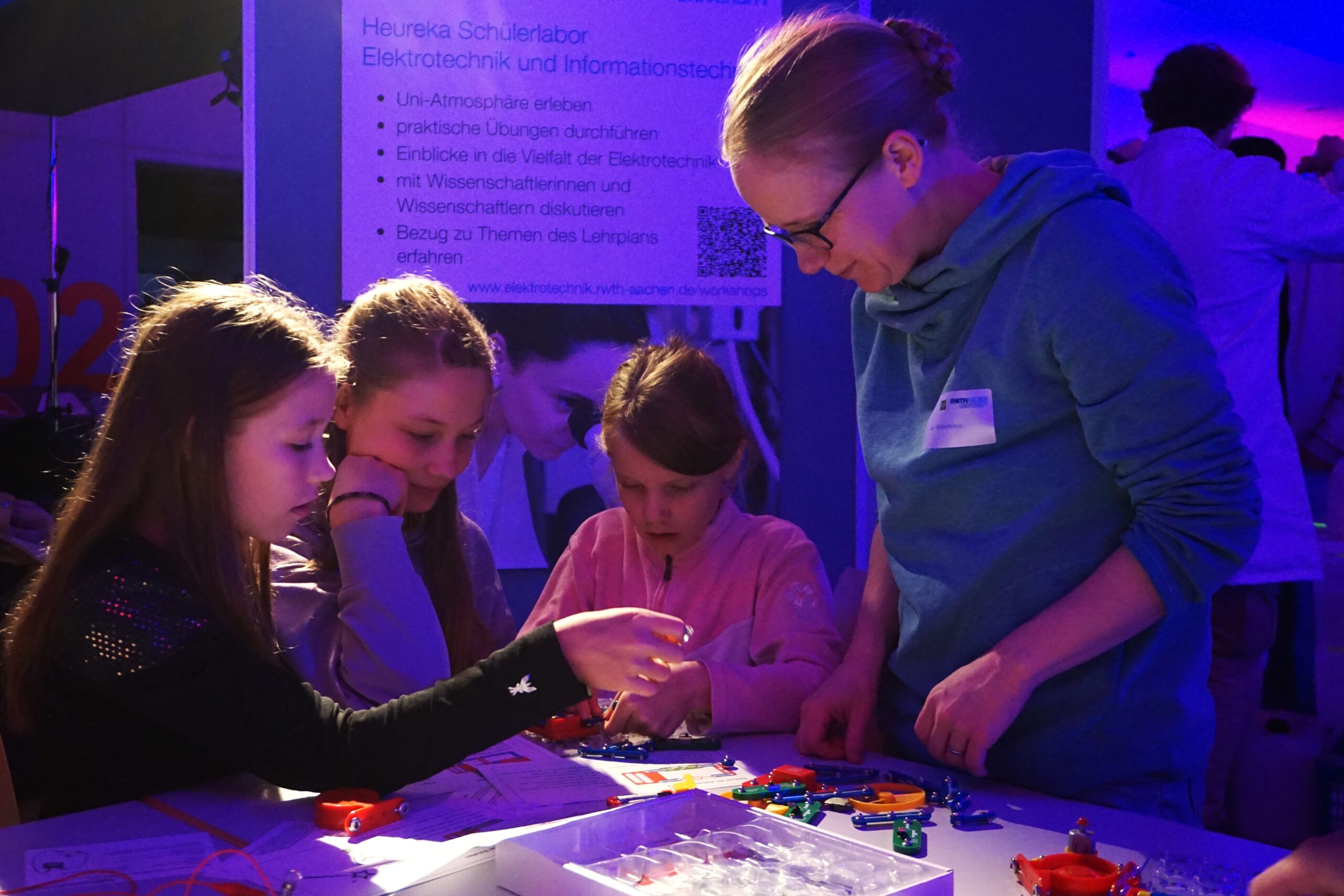
Fakultätsangehörige unterstützen beim Experimentieren mit Stromkreisen
Ältere Kinder „hatten das schon in der Schule“ und stellten ihr theoretisches Wissen gerne auf den Prüfstand. Aber auch Erwachsene fanden sich an unserer Station ein, nutzten die Gelegenheit, mit der Influenzmaschine Blitze zu erzeugen, verweilten gedankenversunken vor dem schwebenden Globus oder studierten aufmerksam das Modell des Stromverteilnetzes, welches der Lehrstuhl für Automation of Complex Power Systems aufgestellt hatte. Die Freude am gemeinsamen Erleben von Forschung und Fortschritt steht bei der Wissenschaftsnacht ganz klar im Mittelpunkt.
„Wir wollen auf unterhaltsame Weise zeigen, was die RWTH alles drauf hat – und zwar so, dass Alle, die etwas wissen wollen, es auch verstehen“, sagte Rektor Ulrich Rüdiger.
Das Potenzial der Wissenschaftsnacht ist folglich noch höher zu veranschlagen: Sie stellt eine wichtige Schnittstelle dar, an der der unmittelbare Wissenstransfer in einem sozialen und kulturellen Kontext erfolgt. Gemäß dem Motto „aus den Laboren zu den Menschen“ leistet dieses jährliche Event einen wichtigen Beitrag zur Förderung der Nähe zwischen Wissenschaft und Gesellschaft.
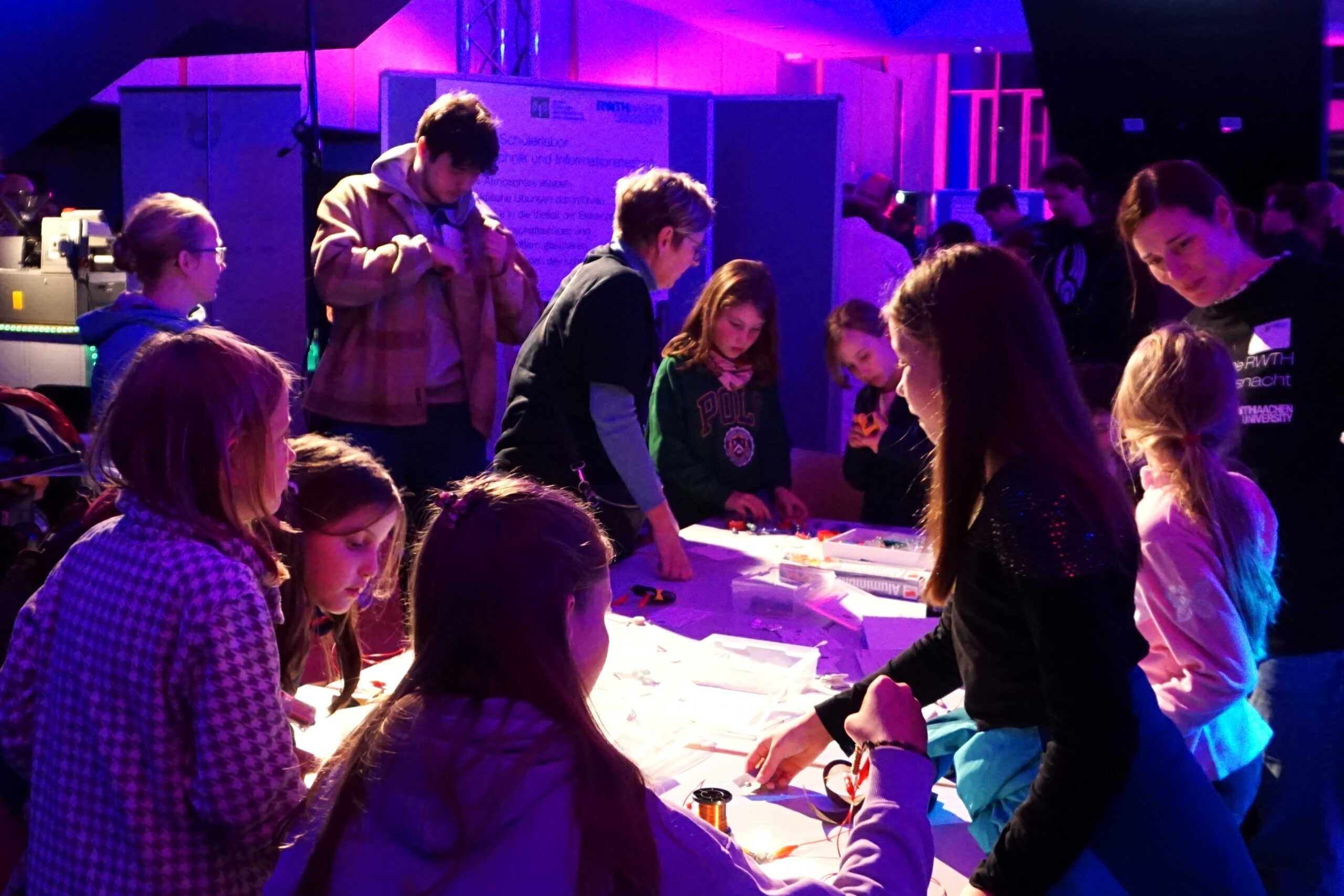
Die Station der Fakultät für Elektrotechnik und Informationstechnik, ausgestattet mit zahlreichen kindergerechten Experimenten
Das Programm der diesjährigen Wissenschaftsnacht erstreckte sich über zehn Hörsäle und zahlreiche Seminarräume. Es gab über 80 Shows und Vorträge, Experimente, Talks und Diskussionen. Von Künstlicher Intelligenz (die Expertinnen und Experten des KI-Centers der RWTH hatten zur Verstärkung noch den Roboter „Pepper“ mitgebracht) bis zum „Jahrmarkt der Physik“, von aktuellen Infos zur US-Wahl und der spektakulären „Faszination Hochspannung“ über Kreislaufwirtschaft bis zu schwimmenden Teslas und der Baustelle der Zukunft. Die Themenpalette war so bunt und vielfältig wie die RWTH selbst.
Weitere Informationen zu dem Programm, sowie Eindrücke und Erfahrungen der Organisatoren – Dezernat für Presse und Kommunikation, Abteilung 3.2 – sind über die Verlinkungen abrufbar.
Professor Leonhardt in die Deutsche Akademie der Technikwissenschaften aufgenommen
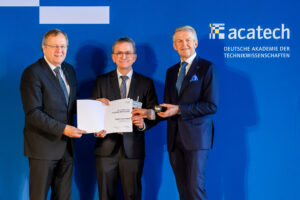
acatech
Berlin, 15.10.2024
Foto: ©Svea Pietschmann
Bereits am 10. 0ktober 2023 wurde Professor Steffen Leonhardt zusammen mit 38 anderen führenden Wissenschaftler*innen in die Deutsche Akademie der Technikwissenschaften aufgenommen.
Änlässlich der Mitgliederversammlung und der acatech Festveranstaltung 2024 in Berlin, durfte dieser nun auch feierlich seine Mitgliedsurkunde entgegennehmen.
Die acatech ist eine Zusammenkunft an gewählten Expert*innen, welche sich der unabhängigen, faktenbasierten und gemeinwohlorientierten Beratung von Politik und Gesellschaft verschrieben hat. Ihr Ziel ist es, nachhaltiges Wachstum durch Innovation zu fördern.
Wir gratulieren herzlich zur Aufnahme dieses wichtigen Ehrenamtes.
„Kolloquium Biomedizinische Technik und verwandte Gebiete“ – Einladung zum aktuellen Vortrag
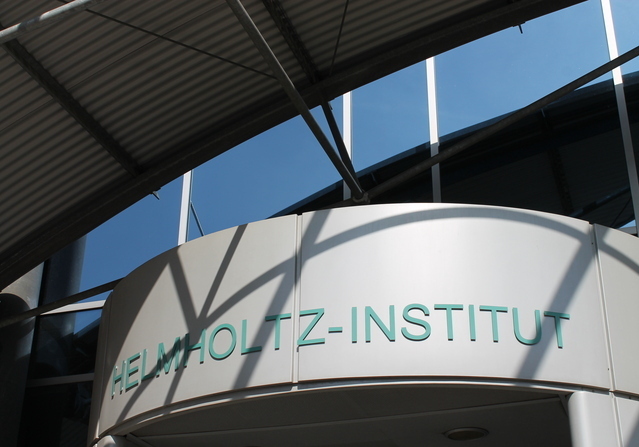
Den Vortrag mit dem Titel: „Electrical impedance of muscle: from muscular dystrophy to Mars“ moderiert Professor Steffen Leonhardt, Inhaber des Lehrstuhls für Medizinische Informationstechnik (MedIT) am Helmholtz-Institut für Biomedizinische Technik der RWTH Aachen, am Mittwoch, den 25.09.2024.
Im Rahmen seines Vortrags wird Dr. Seward B. Rutkove, Nancy Lurie Marks Professor of Neurology, Harvard Medical School Chair, Department of Neurology, Beth Israel Deaconess Medical Center, über Innovationen auf dem Gebiet der elektrischen Impedanz der Skelettmuskulatur referieren. Den Schwerpunkt setzt er auf primäre Störungen, die sich auf die Muskulatur auswirken, einschließlich Muskeldystrophien, amyotropher Lateralsklerose, Muskelverletzungen und die Auswirkungen von Entlastungen wie der bei Mikro- oder Teilschwerkraft. Im Folgenden wird er über die angewandten Methoden und Messtechniken sowie den vorliegenden Datenbestand informieren, welcher unter Zuhilfenahme eines breiten Spektrums an Bedingungen bei Mensch und Tiermodell gewonnen wurde.
„Es ist zu klären, welche analytischen Ansätze bereits vorhanden sind und in welche Richtung die künftige Forschung gehen wird“,
legt Dr. Rutkove der anschließenden Diskussion zugrunde.
Das „Kolloquium Biomedizinische Technik und verwandte Gebiete“ ist eine regelmäßig stattfindende, von der RWTH Aachen organisierte Veranstaltungsreihe. Die Zielsetzung dieser Serie besteht in der fachübergreifenden Weiterbildung in den thematischen Bereichen sowie in der Förderung des interdisziplinären Gedankenaustausches.
Es wird hiermit eine Einladung an alle Studierenden, Klinikerinnen und Kliniker, Ingenieurinnen und Ingenieure sowie Naturwissenschaftlerinnen und Naturwissenschaftler ausgesprochen, an diesem spannenden Vortrag teilzunehmen und sich mit Expertinnen und Experten aus dem Bereich der Biomedizintechnik auszutauschen.
Die Veranstaltung findet von 17:00 bis 17:45 Uhr im Helmholtz-Institut für Biomedizinische Technik der RWTH Aachen, Pauwelsstraße 20, 52074 Aachen, Seminarraum 2.70, statt. Die Koordination liegt bei Univ.-Prof. Dr.-Ing. Klaus Radermacher, Lehrstuhl für Medizintechnik, RWTH Aachen. Für weitere Informationen kontaktieren Sie das Sekretariat unter meditec@hia.rwth-aachen.de oder telefonisch unter +49-(0)241-80 23870.
Who run the work? – Team ÜEW
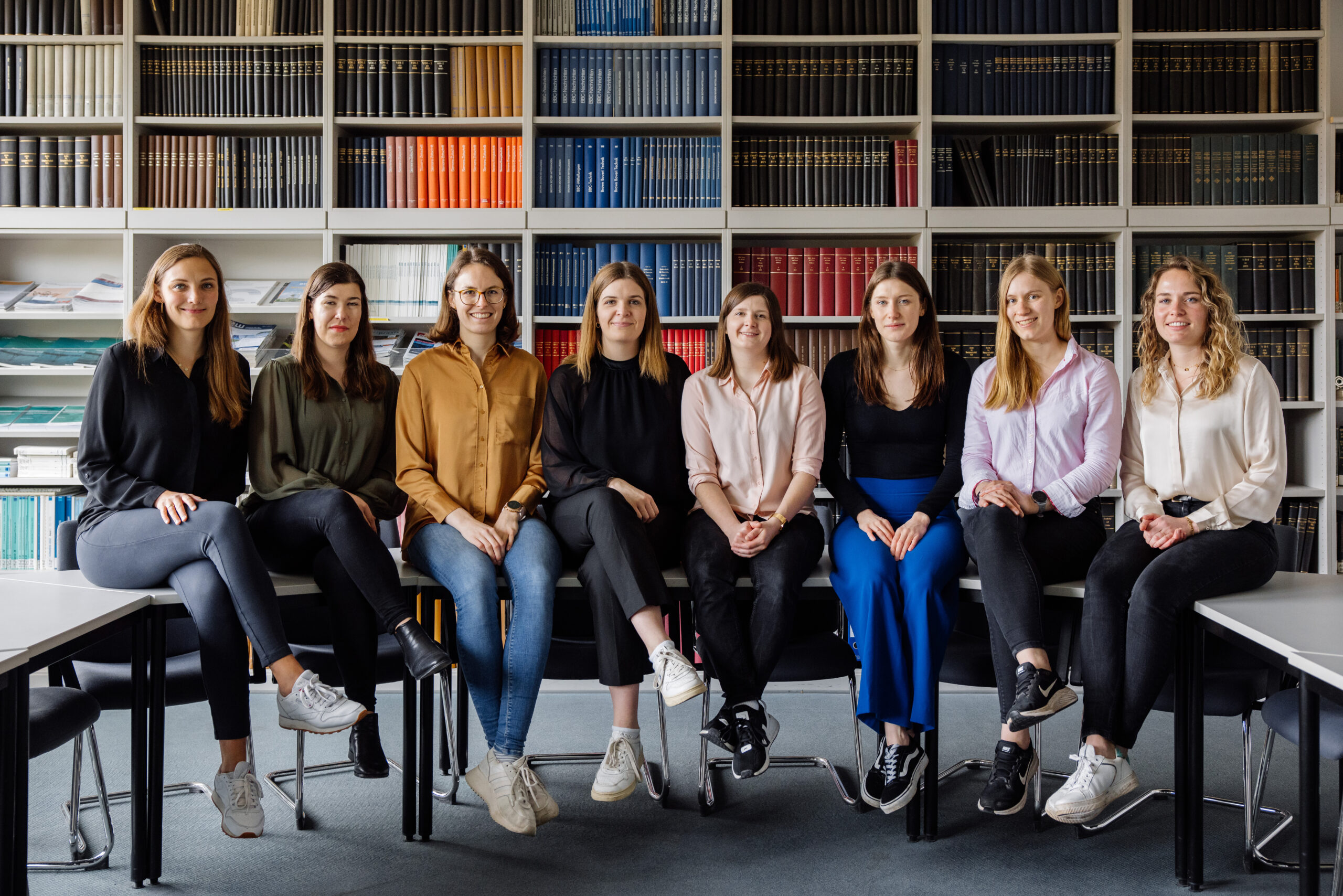
Von links: Stefanie Samaan, Ricarda Kriete, Carolin Guntermann, Sophia Tepe, Lina Fischer, Muriel Krüger, Jana Einsiedle, Claire Lambriex © Martin Braun
Ein Blick in das Team des Lehrstuhls für Übertragungsnetze und Energiewirtschaft (ÜEW) am Institut für Elektrische Anlagen und Netze, Digitalisierung und Energiewirtschaft (IAEW) zeigt ein für die Elektrotechnik erfreuliches Bild: Es besteht zu fast einem Drittel aus weiblichen Mitarbeiterinnen.
Der Frauenanteil in den Ingenieurwissenschaften ist in den letzten Jahren gestiegen und Ingenieurinnen sind insbesondere im Forschungsbereich selbstverständlicher Bestandteil eines Institutsteams. Als wissenschaftliche Mitarbeiterinnen haben alle im Team ein ingenieurwissenschaftliches Studium im Bereich der Elektrotechnik absolviert und sich danach entschieden, eine Doktorarbeit an der Universität anzuschließen und ihre berufliche Karriere hier zu starten. Natürlich setzt die Arbeit in der Elektrotechnik ein gewisses Interesse an Naturwissenschaft und Technik voraus, doch der Schlüssel zum Erfolg und Spaß an den Themengebieten liegt meistens vor allem in der Neugierde, neue Sachverhalte verstehen zu wollen.
„Die Frage: ‚Wie funktioniert das?‘ treibt uns immer wieder an“, sagt Lina Fischer, die an einem robusten Planungsmodell für das zukünftige Energiesystem forscht.
Als nächstes braucht es einfach eine Portion Mut, um solchen Fragen tatkräftig nachzugehen – auch wenn das bedeutet, sich auf etwas Unbekanntes einzulassen.

© Martin Braun
Alle am IAEW verbindet die Vision, Lösungen für die Energiewende zu erforschen und zu erarbeiten. Die Arbeit am Lehrstuhl für Übertragungsnetze und Energiewirtschaft beschäftigt sich vor allem mit der Frage:
„Wie sollen wir das zukünftige Energiesystem gestalten, sodass es umweltverträglich, versorgungssicher und gesamtwirtschaftlich effizient ist?“
Thematisch umfasst dies ein großes Spektrum an interessanten Aspekten. So dreht sich viel darum, wie die großen Energiemengen aus Photovoltaik- und Windenergieanlagen aber auch alternative Energieträger wie Wasserstoff in unser derzeitiges Energiesystem integriert werden können. Essentiell hierfür ist das Übertragungsnetz für Strom, welches man im Alltag z.B. an den neben den Autobahnen verlaufenden Hochspannungsleitungen erkennt. Dieses ermöglicht es, Strom über große Distanzen zu transportieren und somit die großen Energiemengen aus Windkraftanlagen in Norddeutschland zu Regionen mit hohem Stromverbrauch zu transportieren. Im Rahmen von aktuellen Projekten wird dabei untersucht, wie das Übertragungsnetz zukünftig ausgebaut und betrieben werden muss, um die Energiewende zu ermöglichen. Auch wird erforscht, an welchen Standorten zukünftig Leitungen zu den Offshore-Windkraftanlagen in der Nord- und Ostsee angeschlossen oder große Elektrolyseanlagen zur Produktion von Wasserstoff positioniert werden sollten. Solche Untersuchungen müssen neben technischen Aspekten der Komponenten auch wirtschaftliche Aspekte miteinbeziehen, wie z.B. die entstehenden Kosten durch Investitionen oder mögliche Engpässe im Übertragungsnetz.
Generell spielt die Betrachtung von wirtschaftlichen und marktlichen Aspekten bei der Umgestaltung des Energiesystems eine große Rolle. Durch die europäischen Bestrebungen, den Stromhandel zwischen den einzelnen Ländern weiter zu stärken, kommt es zu zunehmenden Handelsflüssen in Europa und dadurch zu weiteren Herausforderungen für die Transportaufgaben im Übertragungsnetz. Daher werden am Lehrstuhl Methoden und Modelle für die Simulation der europäischen Strommärkte entwickelt. So können verschiedene Zukunftsentwicklungen untersucht und ihre potenziellen Auswirkungen für die Marktteilnehmer sowie das Übertragungsnetz analysiert werden.
Ein weiterer Themenschwerpunkt des Lehrstuhls ist es, sich mit innovativen Betriebsmitteln und Konzepten zu beschäftigen, welche zukünftig einen sicheren Betrieb der Übertragungsnetze gewährleisten und so vor Blackouts schützen sollen. Hierfür müssen vor allem Modelle und Verfahren entwickelt werden, die das dynamische Systemverhalten der Übertragungsnetze und ihrer Komponenten unter neuen Rahmenbedingungen abbilden und untersuchen können.
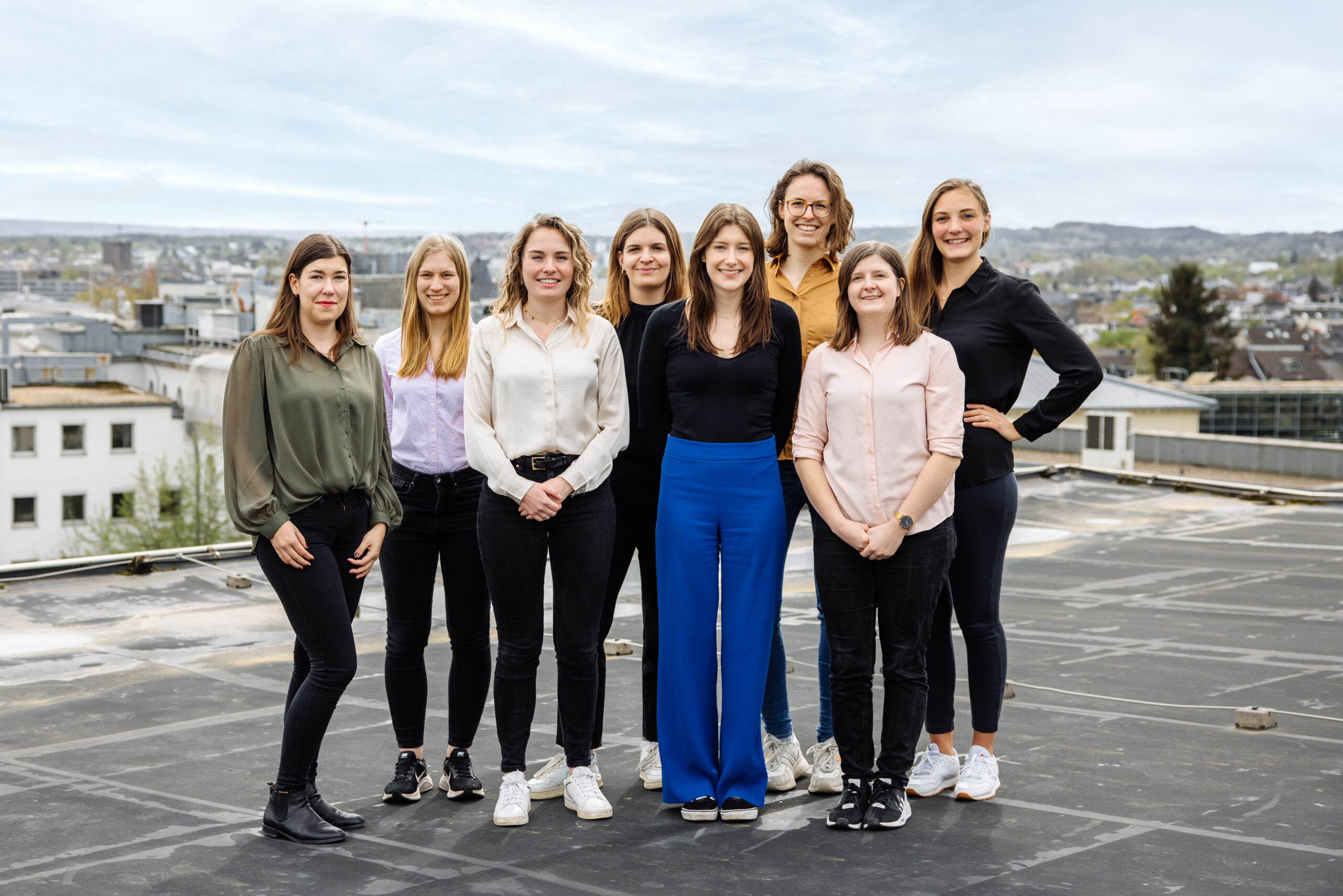
© Martin Braun
Wenn man an die Arbeit an einem Institut der Universität denkt, drehen sich die ersten Gedanken meistens um die alleinige Arbeit an einem eigenen Forschungsvorhaben. Dies vermittelt besonders im Bereich der Ingenieurwissenschaften oft einen falschen Eindruck des Arbeitsalltags an einem Institut. So ist die Arbeit am IAEW vor allem durch die Vielfalt an verschiedenen Projekten mit sowohl Forschungs- als auch Industriepartnern geprägt. Dies erlaubt es, unterschiedliche Themengebiete kennenzulernen und vielfältige Erfahrungen zu sammeln. Häufig ist man ab der Anbahnung der Projekte über die Bearbeitung bis hin zur Präsentation der Ergebnisse involviert. Die unterschiedlichen Projektteams machen die Zusammenarbeit dabei abwechslungsreich. Durch die Zeit am Institut bietet sich dadurch die Möglichkeit, neben wissenschaftlichen Erkenntnissen auch eine Reihe an Fähigkeiten zu erwerben, die für Führungsaufgaben in der Industrie qualifizieren.
Natürlich erlebt man auch abseits des Arbeitsalltags vielerlei Dinge, die die Arbeit am Institut lohnenswert machen.
„Besonders die gemeinsamen Aktivitäten mit anderen jungen Kolleginnen und Kollegen nach der Arbeit, diverse Institutstraditionen, Feste und sportliche Events gehören mit dazu.“
Das IAEW bietet dabei insbesondere auch die Möglichkeit, schon während des Studiums durch eine Hiwi-Stelle oder eine Abschlussarbeit Einblicke in den Institutsalltag und die Forschungsthemen zu bekommen.
Lass dich inspirieren und finde deinen eigenen Weg!
Auf unserer Website informieren wir dich über unser Studienangebot.
Team AixSense erfolgreich beim SensUs Wettbewerb 2024
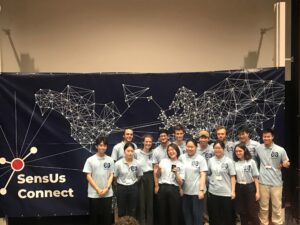
Das diesjährige AixSense-Team bei der SensUs 2024 ©RWTH
Mit ihrem Biosensor zur Überwachung bei Nierenversagen überzeugt das RWTH-Team
Bereits zum siebten Mal nahm das 15-köpfige Studierendenteam AixSense erfolgreich am SensUs Wettbewerb der Technischen Universität Eindhoven teil. Bei dem internationalen Wettbewerb traten in diesem Jahr 18 Teams mit ihren Point-of-Care (PoC)-Biosensorlösungen für den Echtzeit-Nachweis von Kreatinin zur Überwachung von akutem Nierenversagen gegeneinander an. Unter anderem gehören auch 3 Studierende der japanischen Partneruniversität Tokyo Institute of Technology zum AixSense-Team.
AixSense hohlt diese Jahr in drei von fünf Kategorien mit ihrem PoC den Sieg und belegt auch in den Kategorien technologische Neuheit und technische Machbarkeit jeweils den zweiten Platz. Besonders hervorzuheben ist dabei auch die Leistung im Bereich Öffentlichkeitsarbeit und wissenschaftlichen Kommunikation, für ihr Videotagebuch erhält das Aachener Team den Vlog Award und auch das öffentliche Voting für den Public Inspirations Award entscheidet AixSense für sich.
Bereits seit 2018 engagiert sich das Institut für Werkstoffe der Elektrotechnik 1 der RWTH Aachen im Wettbewerb. Professor Sven Ingebrandt und Dr. Vivek Pachauri stellen hierfür jährlich ein Team aus diversen Studiengängen zusammen. Unterstützt wird das Team von verschiedenen Strukturen und Profilbereichen der RWTH, wie zum Beispiel dem Zentrallabor für Mikro- und Nanotechnologie (ZMNT), welches das Team in technischen Fragen berät.
Der jährliche Wettbewerb regt zur internationalen und interdisziplinären Zusammenarbeit im Rahmen, unter anderem, der Elektrotechnik und Mikro-Nano-Technologie, transformativen Materialien, der Biologie, der Ingenieurwissenschaften und der medizinischen Wissenschaften an.
Für den SensUs-Wettbewerb 2025 können sich Interessierte bis November 2024 bei pachauri@iwe1.rwth-aachen.de bewerben.





